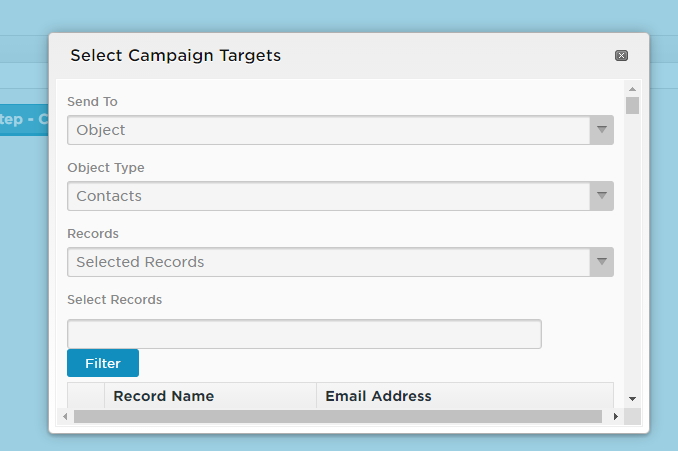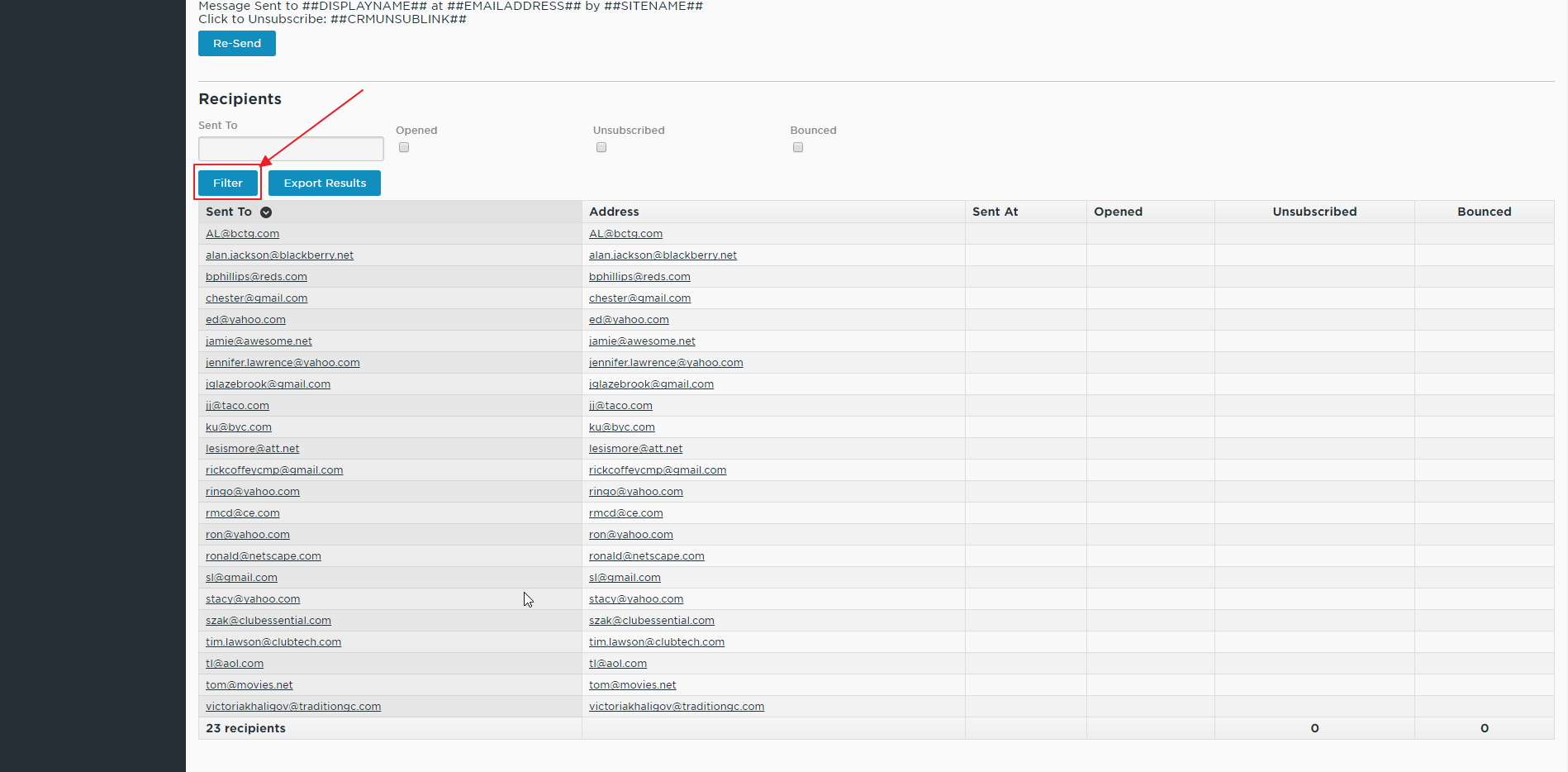...
Table of Contents
| Table of Contents | |||
|---|---|---|---|
|
...
| Widget Connector | ||||||
|---|---|---|---|---|---|---|
|
...
|
| Widget Connector | ||||||||||
|---|---|---|---|---|---|---|---|---|---|---|
|
Use Case(s)
Oftentimes, Clubs will utilize Campaigns to reach out to Prospects based on their funnel stage, lead source, or interests. Additionally, Clubs may utilize Campaigns to reach out to Members who have not been to the Club in awhile, as determined by a Member’s online reservation history.
...
...
...
...
...
To send to an Object, follow the below steps:
...
...
...
...
...
...
...
...
...
...
...
...
...
To access a list of all the Campaigns that have been sent via your CRM, and to view the statistics for each Campaign, click on the Campaign History link in the sidebar, under the Communication section.
Campaign History Overview
The first screen you will see once you click on Campaign History in the sidebar is the Campaign History Overview. Here, you are able to view an overview of all Campaigns sent via your CRM, with some aggregated statistics for each.
The filters at the top of this page allow you to adjust which Campaigns display in the bottom part of the page. You can filter your results upon the following criteria:
- Campaign Name: This is the name entered in the Properties section for each Campaign.
- Subject: This is the subject of the email that was sent.
- Sent By: Enables you to choose from the list of all available outgoing addresses in your CRM.
- Type: Choose between Email and Mail Merge.
- Sent On or After & Sent On or Before: Enables you to view all Campaigns sent between the dates that you choose in these respective fields. Be sure to accurately set the necessary date range to return the specific Campaign(s) you wish to view statistics for.
Beneath these filters is a list of all the messages that have been sent via Campaigns in your CRM that meet the criteria as specified by the filters. See below for a brief description of each column in this report:
- Campaign Name: This is the name you entered in the Properties section of your Campaign. Click on this name to view statistics for this individual Campaign, including a list of all messages that were sent as part of this Campaign (in the event that the Campaign was sent on a recurring basis).
- Message Subject: This is the subject of the emails that were sent out in this Campaign. You can click on this name to view a more detailed overview of the statistics for this specific message.
- Sent By: Displays the email address that this message was sent from.
- Selected Recipients: Displays the number of email addresses that were targeted with the Campaign.
- Recipients Sent To: Displays the number of email addresses that actually had the message sent to them. Typically, if this number is lower than the total of Selected Recipients, it is due to unsubscribes or duplicate email addresses.
- Opened: Displays the number of messages that were opened by the recipients.
- Open Rate: Displays the percentage of recipients that opened the email to those that received the message, but never opened it.
- Link Clicks: Calculates the total number of clicks on hyperlinks included within the email message. You can view a breakdown of link clicks per hyperlink by clicking on the Message Subject.
- Timestamp: Displays the time that the message was sent from the system.
- Re-Send: Enables you to send this exact message again, to the same group of targets, or a subset of the original group of targets. Your sending options are:
- Use Campaign Targets: Will send the new message to the exact same group of targets as the original Campaign was sent to.
- Use Campaign Targets, Ignore Recipients Who Opened Original: Will send the new message to ONLY those contacts who received the original message, but did not open it.
- Original Recipients Only: Will send the new message to those contacts that the original message was sent to. This is different from Use Campaign Targets because it excludes any contacts that were targeted, but did not have the message sent to them, either due to a missing email address from their CRM record, their email address already being present in the target list in a different CRM record (duplicate email addresses), or because they had previously unsubscribed from your CRM Campaigns.
- Original Recipients Only, Ignore Recipients Who Open Original: Same as the previous option, excluding those who opened the original email.
The statistics on this initial screen serve as an overview of your sent Campaigns. If you need to “drill down” deeper into any given Campaign, or even a specific Message from within a Campaign, you can do so by clicking either the Campaign Name or Message Subject.
Campaign Details
To access the details of a Campaign as a whole (especially for those with recurring messages), click on the Campaign Name from the Campaign History screen. Here, you will be able to review the properties of this Campaign, as well as view an overview of all the individual messages that have been sent as part of this Campaign.
The details in this section are very similar to those on the previous screen, but this view allows you to easily gauge the long-term effectiveness of recurring email Campaigns. You are also able to drill down into the message details of any message in the list by clicking on the Message Subject of that message.
Message Details
To access the details of a message sent through a Campaign, click on its Message Subject from either the main Campaign History screen, or from the Campaign Details screen. Here, you will be able to view the properties of the Campaign that this message was a part of, as well as review the body of the email itself.
Further down, you will see a list of all the links contained within this email, and how many clicks each link received. You are able to see a list of all the contacts that clicked on the link by clicking on the number in the Clicks column.
The last section on this screen displays a list of all the recipients of this message. You are able to filter the results to track down a specific email address, by typing that address into the box labelled Sent To and clicking the Filter button. You are also able to filter the results on the following three categories:
- Opened: When this box is checked, only recipients that opened the message will appear in the listing below.
- Unsubscribed: When this box is checked, only recipients that clicked on the unsubscribe link within your message will appear in the listing below.
- Bounced: When this box is checked, only recipients that had the message bounce back from their email address (meaning they were unable to actually receive the message) will appear in the listing below.
The statistics that are shown for each recipient are broken out as follows:
- Sent To: Displays the CRM record that this message was sent to. Click on this name to display the message history for this record.
- Address: Displays the email address that corresponds with the CRM record that this message was sent to. Click on this address to generate a new email to this email address.
- Sent At: Displays the timestamp at which this message was sent from Clubessential’s email servers to the recipient.
- Opened: Displays the time that the recipient opened the message. If the recipient did not open the message, this field will remain blank.
- Unsubscribed: Displays the time that the recipient unsubscribed from the message. If the recipient did not unsubscribe from this message, this field will remain blank.
- Bounced: Displays the time that this message was marked as having bounced. If the message was delivered successfully, this field will remain blank.
- Link Clicks: Displays the number of times that this recipient clicked on any link within the message.
FAQs
Q: How can I manually select which contacts to target with my Campaign?
A: Sending to an Object:
- Send To: Choose Object
- Object Type: Choose the Object to send to (most likely Contacts)
- Records: Choose All Records to send this Campaign to ALL records within your CRM. Choose Selected Records to bring up an additional section for you to select individual contacts.
- Select Records: This section appears when you select Selected Records in the option above. Search for contacts by name in the search bar, and click Filter to narrow down the list. Check the box next to each contact that you would like to send this Campaign to.
- Email Fields: Select the CRM email field(s) that you would like to target for each selected record you’ve chosen.
- Return Email Targets: Click this button once you have filled out each of the options above, and your targets will be selected for this Campaign!
...
...
...
Best Practices
- Always be sure to send a Test of your message before finishing your Campaign. This allows you to be sure that the formatting of your email is correct when viewed from within an actual email client. Microsoft Outlook is particularly notorious for displaying certain elements of email messages differently than the rest of the internet, so if you have this installed on your computer, it can be beneficial to send yourself a test there to troubleshoot.
- If you are sending your Campaign to the results of a Query, run that query before sending, and go through the results to ensure that the contacts returned are exactly who you expect them to be. If you notice any discrepancies, don’t hesitate to contact your CRM Support Team!











